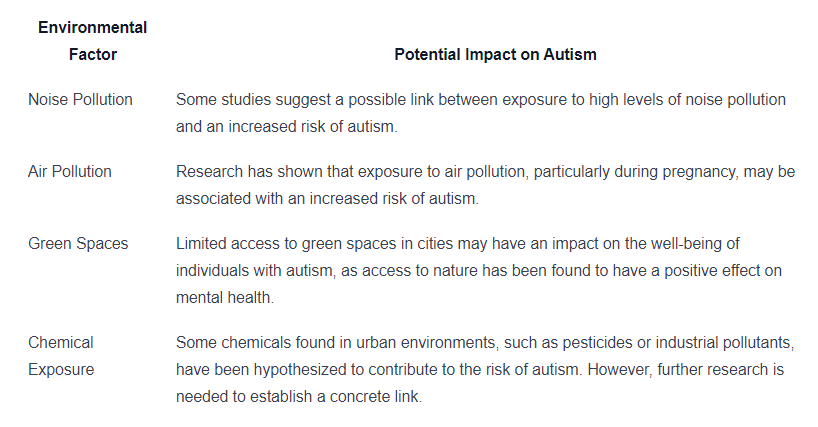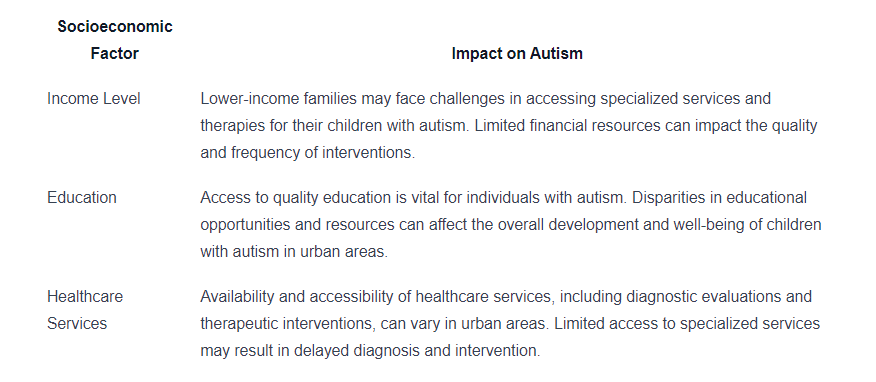Does Living in a City Cause Autism?
Unveiling the truth: Does city living cause autism? Uncover the facts behind urban legends and the relationship between cities and autism.

Urban Legends: City Living and Autism
In recent years, there has been speculation regarding the potential connection between city living and autism. This section aims to introduce the topic and provide a clear understanding of autism and its prevalence.
Introduction to the Topic
Living in urban areas offers a multitude of benefits, such as access to diverse opportunities, cultural experiences, and essential services. However, concerns have arisen regarding the impact of the urban environment on the development of autism. It is essential to examine this topic objectively and explore the available research before drawing any conclusions.
Defining Autism and Its Prevalence
Autism, also known as Autism Spectrum Disorder (ASD), is a complex neurodevelopmental condition that affects social interaction, communication, and behavior. It is characterized by a wide range of symptoms and varying degrees of impairment. Individuals with autism may exhibit repetitive behaviors, difficulties with social interactions, and challenges in verbal and non-verbal communication.
According to the Centers for Disease Control and Prevention (CDC), autism is relatively common, with an estimated prevalence of around 1 in 54 children in the United States. It is important to note that autism affects individuals across all backgrounds, regardless of their geographic location.
To better understand the relationship between city living and autism, it is necessary to examine the urban environment and the research studies conducted on this topic. The following sections will delve deeper into these aspects to provide a comprehensive understanding of the subject matter.
Examining the City Living and Autism Connection
As the topic of the relationship between city living and autism continues to be discussed, it is important to examine the available research and understand the nuances of this connection. In this section, we will explore the urban environment and the research studies conducted on the potential link between city living and autism.
Understanding the Urban Environment
Cities are characterized by their bustling nature, with higher population densities, increased noise levels, and various environmental factors. Some studies have suggested that certain aspects of the urban environment, such as air pollution, noise pollution, and exposure to certain chemicals, may potentially contribute to the development of autism spectrum disorder (ASD).
It is important to note that the urban environment is complex, and it is difficult to isolate specific factors that may directly cause autism. Additionally, there is a wide variation in the urban environment across different cities and regions, further complicating the analysis of its relationship with autism.
Research Studies on City Living and Autism
Several research studies have been conducted to explore the potential connection between city living and autism. These studies aim to understand if there is a higher prevalence of autism in urban areas compared to rural or suburban areas.
In a study published in the journal JAMA Psychiatry, researchers analyzed data from over 4 million children in Sweden. They found that children living in urban areas had a slightly higher risk of developing autism compared to those in rural areas. However, it is important to note that the absolute increase in risk was small, suggesting that other factors may also play a significant role in the development of autism.
Another study published in the journal Environmental Health Perspectives examined the association between air pollution and autism in California. The researchers found a positive association between exposure to air pollution during pregnancy and the risk of autism in children. However, further research is needed to better understand the specific mechanisms behind this association.
While these studies provide some insights into the potential link between city living and autism, it is important to approach the findings with caution. The relationship between the urban environment and autism is complex and multifaceted, involving a range of genetic, environmental, and socio-economic factors.
By examining the available research, we can gain a better understanding of the city living and autism connection. However, it is important to remember that further research is needed to unravel the intricacies of this relationship and to better inform policies and interventions that promote the well-being and support of individuals with autism in urban environments.
Factors to Consider
When exploring the relationship between city living and autism, it is important to consider various factors that may contribute to the development or prevalence of autism in urban areas. Two key factors to consider are environmental factors in cities and socioeconomic factors that influence access to services.
Environmental Factors in Cities
Cities are characterized by a unique set of environmental factors that may potentially impact the risk of autism. These factors can vary from noise pollution and air pollution to the availability of green spaces and exposure to certain chemicals. While research is still ongoing, some studies have suggested that certain environmental factors in urban areas could be associated with an increased risk of autism.

Socioeconomic Factors and Access to Services
Socioeconomic factors, including income level, education, and access to healthcare services, play a significant role in the lives of individuals with autism living in urban areas. These factors can influence the availability and quality of services and support systems that are essential for individuals with autism and their families.

Understanding these factors is crucial in comprehending the complex relationship between city living and autism. By considering the environmental factors present in cities and the socioeconomic factors that influence access to services, we can gain a more comprehensive understanding of the potential factors at play. It is important to note that while these factors may be relevant, further research is needed to establish a definitive causative relationship between city living and the development of autism.
Debunking Myths
In examining the relationship between city living and autism, it's important to address some common misconceptions and clarify the distinction between correlation and causation.
Dispelling Misconceptions
There are several misconceptions surrounding the idea that living in a city causes autism. It's crucial to dispel these myths and provide accurate information to promote a better understanding of the topic.
- Myth: Living in a city directly causes autism. This is not supported by scientific evidence. Autism is a complex neurodevelopmental disorder with a multifactorial etiology, involving a combination of genetic and environmental factors. Living in a city does not cause autism on its own.
- Myth: City pollution is a significant factor in autism development. While environmental factors may play a role in autism, the relationship between pollution and autism is still being studied. It's important to note that autism is a complex condition, and there is no singular cause or factor that can be solely attributed to its development.
- Myth: Rural areas have a lower prevalence of autism. The prevalence of autism is not limited to urban areas. Studies have shown that autism is found in both urban and rural communities. The difference in prevalence rates can be attributed to various factors, including differences in access to diagnostic services and awareness.
Clarifying Correlation vs. Causation
When discussing the relationship between city living and autism, it's crucial to understand the distinction between correlation and causation. Correlation refers to a statistical relationship between two variables, while causation implies a cause-and-effect relationship.
- Correlation: Research studies have identified a correlation between living in urban areas and a higher prevalence of autism. However, correlation does not imply causation. Other factors, such as access to diagnostic services and socioeconomic disparities, may contribute to the observed correlation.
- Causation: It is important to approach the topic of causation with caution. While some studies have suggested a possible link between environmental factors in urban areas and autism, more research is needed to establish a causal relationship. Autism is a complex condition influenced by a combination of genetic and environmental factors, and it is unlikely that any single factor can be solely responsible for causing autism.
To better understand the relationship between city living and autism, it is vital to consider the multifaceted nature of the disorder and the various factors that contribute to its development. By dispelling misconceptions and clarifying the distinction between correlation and causation, we can foster a more informed and nuanced understanding of this topic.
Support and Interventions
When it comes to supporting individuals and families affected by autism who live in urban areas, various resources and interventions are available. These resources aim to provide assistance, guidance, and access to necessary services for individuals with autism and their families.
Resources for Families Living in Urban Areas
Living in urban areas can present unique challenges for families with a child on the autism spectrum. However, there are numerous resources available to help navigate these challenges and provide necessary support. These resources may include:
- Autism Support Organizations: Non-profit organizations specializing in autism offer a wide range of support services, including information, advocacy, and community networks. They can provide valuable resources and connect families with local support groups, workshops, and educational opportunities.
- Special Education Programs: Urban areas often have a higher concentration of schools and programs that cater to individuals with special needs, including autism. These programs may offer specialized curriculum, therapies, and support services designed to meet the unique needs of children with autism.
- Therapies and Interventions: Urban areas typically have a greater availability of specialized therapists and intervention services for individuals with autism. These may include speech therapy, occupational therapy, applied behavior analysis (ABA), and other evidence-based interventions.
- Parent Support Groups: Connecting with other parents who have children with autism can be invaluable. Urban areas often have established support groups where parents can share experiences, exchange information, and provide emotional support to one another.
It's important for families living in urban areas to actively seek out these resources to ensure they have the support they need to navigate the challenges of raising a child with autism.
Importance of Early Detection and Intervention
Early detection and intervention are crucial for individuals with autism, regardless of whether they live in urban or rural areas. However, living in an urban environment can sometimes provide advantages in terms of accessibility to early detection and intervention services.
Early detection involves recognizing the signs and symptoms of autism at an early age. This allows for timely intervention and support, which can significantly improve long-term outcomes for individuals with autism. Urban areas often have a higher concentration of healthcare professionals, specialists, and diagnostic centers, making it more accessible for families to seek early detection and diagnosis.
Intervention services play a vital role in supporting individuals with autism in reaching their full potential. These interventions may include behavioral therapies, speech and language therapy, occupational therapy, and social skills training. Urban areas usually have a broader range of intervention services and qualified professionals who can provide these specialized treatments.
By prioritizing early detection and intervention, families living in urban areas can maximize the opportunities available for their child's development and overall well-being.
In conclusion, families living in urban areas can access a variety of resources and interventions to support individuals with autism. These resources, along with early detection and intervention, play a significant role in empowering individuals with autism and their families to navigate the challenges of city living and thrive in their communities.
Moving Forward
As we continue to explore the relationship between city living and autism, it is important to focus on promoting inclusivity and understanding for individuals with autism spectrum disorder (ASD). Additionally, further research is needed to deepen our understanding of this complex topic.
Promoting Inclusivity and Understanding
Moving forward, it is crucial to create inclusive environments that support individuals with ASD in urban areas. This can be achieved through various means, such as:
- Enhancing accessibility: Cities should strive to improve accessibility for individuals with ASD by implementing accommodations such as sensory-friendly spaces, clear signage, and inclusive public transportation options.
- Education and awareness: Raising public awareness about autism and dispelling myths and misconceptions is essential for fostering understanding and acceptance. Educational campaigns and community initiatives can play a significant role in promoting inclusivity.
- Support networks: Establishing support networks and resources within urban communities can provide valuable assistance to families and individuals affected by ASD. These networks can offer guidance, information, and a sense of community.
Future Research Directions
To gain a deeper understanding of the relationship between city living and autism, it is important to continue conducting research in this field. Some potential future research directions include:
- Longitudinal studies: Conducting long-term studies that follow individuals with ASD living in urban areas over an extended period can provide valuable insights into the developmental trajectories and outcomes associated with city living.
- Environmental factors: Investigating specific environmental factors that may contribute to the development or exacerbation of symptoms in individuals with ASD. This could include examining the impact of pollution, noise levels, access to green spaces, and other aspects of the urban environment.
- Socioeconomic factors: Further exploring the role of socioeconomic factors, such as income disparities, access to healthcare services, and educational resources, in understanding the relationship between city living and autism.
- Intervention strategies: Researching and developing effective intervention strategies targeted towards individuals with ASD in urban areas. This could involve exploring the efficacy of community-based programs, early intervention initiatives, and support services tailored to the unique needs of urban populations.
By promoting inclusivity and understanding and continuing to advance our knowledge through further research, we can work towards creating supportive environments that accommodate the needs of individuals with autism in urban settings. This will contribute to a more inclusive and accepting society for all.
Sources
https://www.crossrivertherapy.com/autism/does-living-in-a-city-cause-autism
https://www.ncbi.nlm.nih.gov/pmc/articles/PMC4511947/
https://www.ncbi.nlm.nih.gov/pmc/articles/PMC2882422/
Similar articles
We’re here to help you

Our team is here to assist you in this process. Contact us for any assistance.
it’s easy to apply
We Accept Most Insurances
Our in-network insurance partnerships make ABA therapy more accessible to families throughout our service areas.







Our Insurance Process
We'll request your insurance details to help us verify your plan's coverage for ABA therapy. Once we've received this information, we'll walk you through your benefits, including copayments, deductibles and out-of-pocket maximums, so you know what to expect in advance.
Our team will then handle the preauthorization and all the necessary paperwork.
.svg)





















.jpeg)


































.jpeg)




.jpeg)







.jpeg)











.jpeg)
















